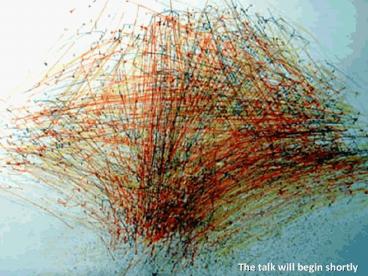The talk will begin shortl - PowerPoint PPT Presentation
1 / 59
Title: The talk will begin shortl
1
The talk will begin shortly
2
Economic Complexityand Economic GrowthTowards
a periodic table of production
- Cesar A. Hidalgo PhD
Center for International Development Harvard
Kennedy School http//www.chidalgo.com
3
(No Transcript)
4
How does a country learn how to produce all
possible products?
How does a group of people organize to produce a
product?
MANY PRODUCTS, BIG HOMEWORK
5
(No Transcript)
6
Designer
Programmer
Hardware Knowledge
Mechanic
Webpage
Fashionable Electronic
Southern California Rich people toys
7
(No Transcript)
8
CA Hidalgo, B Klinger, A-L Barabasi, R
Hausmann.Science (2007)
9
Patterns of Comparative Advantage
10
Malaysia
1985
2000
11
China
1975
1985
2000
12
Mexico
1985
2000
13
Countries are more likely to jump towards
products that are close by
CA Hidalgo, B Klinger, A-L Barabasi, R
Hausmann.Science (2007)
14
Society
15
A similar story.
16
What is matter made of?
17
(No Transcript)
18
(No Transcript)
19
(No Transcript)
20
First economic quantification
Saa
E-Sa Saa log(Saa)
HSa S2aa
DSa Saa F(Saa)
21
Quantifying Economic Complexity
Maa
1 if country a exports product a
1006 product categories
132 countries
22
Method of Reflections
23
Method of Reflections
Degree (Countries)
Degree (Products)
24
Method of Reflections
k1 Standardness Average ubiquity of products
exported by a country
Mirror
Product p1
Country C1
Country C1
Product p2
Country C2
Country C2
Product p3
Country C3
Country C3
Product p4
25
Method of Reflections
k1 Complexity Average diversification of a
products exporters
Product p1
Product p1
Country C1
Product p2
Product p2
Country C2
Product p3
Product p3
Country C3
Product p4
Product p4
26
Method of Reflections
Country Variables
Product Variables
k0 k1 k2 k3 k4
k0 k1 k2 k3 k4
27
Method of Reflections
Country Variables
- 0 How many products you export?
- 1 How rare are the products you export?
- 2 How many products should you export based on
the products you export? - How ubiquitous should your exports be
based on the countries that export them?
We can characterize a country by k1, k2, ... kN
We can characterize a product by k1, k2, kN
28
(No Transcript)
29
Method of Reflections k-k1 diagram
Poorly Diversified Producing Common Products
Highly Diversified Producing Common Products
Standardness k1
Highly Diversified Producing Exclusive Products
Poorly Diversified Producing Rare Products
Diversification k
30
Method of Reflections k-k1 diagram
31
Method of Reflections k-k1 diagram
Produced in Few, Highly Diversified, Countries
Produced in Many Highly Diversified Countries
Complexity k1
Produced in Many Non Diversified Countries
Produced in Few Non-Diversified Countries
Ubiquity k
32
Method of Reflections k-k1 diagram
33
Method of Reflections Null Models
34
Method of Reflections k-k1 diagram and null
models
35
Method of Reflections k-k2, k1-k2 diagrams and
null models
36
Method of Reflections k-k1 diagram and null
models
37
Method of Reflections k-k2, k1-k2 diagrams and
null models
38
Method of Reflections k, k1 and GDP per capita
(ppp)
39
(No Transcript)
40
Method of Reflections k, k1 and PRODY
41
Method of Reflections 20 year Growth
42
Method of Reflections 20 year Growth
43
Method of Reflections 10 year Growth
44
Method of Reflections 5 year Growth
45
Method of Reflections 5 year growth, fixed
country effects
46
Method of Reflections Predicts network
properties of future products
47
Method of Reflections Predicts network
properties of future products
48
The Lego Theory of Development
49
(No Transcript)
50
(No Transcript)
51
(No Transcript)
52
Countries
How many different pieces you have?
How rare are your pieces?
53
If you have
Many different pieces
We might expect you to build manyproducts,
including those requiringmany different pieces
and rare pieces.
High Diversification (k0), Low Standardness (k1)
Few different pieces
We expect you to build few products, thatare
made by many others, as it is likely to have
those few pieces
Low Diversfication (k0), High Standardness (k1)
54
If a product requires
Many different pieces
We might expect you to find that product In few
countries that have many pieces and therefore
build many products
Low ubiquity (k0), High complexity (k1)
Few different pieces
We expect to find that products in
many Countries, including those with few pieces
High ubiquity (k0), Low complexity (k1)
Few rare pieces
We expect to find that products in few countries
Low Ubiquity (k0)
55
Concluding Remarks
INTRODUCTION 1.- The product space is
heterogeneous and can be approximated by studying
export data using network methods. 2.- The
heterogeneity of the product space matters for
development. (The location of a country in the
product space determines their ability to
diversify) MAIN BODY 1.- We can quantify the
productive structure of countries and the
sophistication of products by studying exports
as a bipartite network. 2.- This network
characterization of productive structure is
associated with income and growth, suggesting
that it is able to capture some fundamental
properties of production. FINALE 1.- We can
explain some of this observations using the Lego
Theory of Development
56
Acknowledgments
My Family
Ricardo Hausmann
CCNR
CID
57
Contact Info http//www.chidalgo.com
58
Method of Reflections
Country Variables
Product Variables
k0 k1 k2 k3
Diversification Number of products exported by a
country.
Ubiquity Number of countries exporting a product.
k0 k1 k2 k3
Complexity Average diversification of
a Products exporters
Standardness Average Ubiquity of a
countrys Products
k2 Average level of diversification associated
with a countrys products.
k2 Average standardness of a products producer
k3 Average ubiquity associated with products
according to their producer
k3 Average complexity of a products producer
59
Quantifying Economic Complexity
Product Space
Productivity Space































